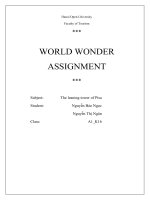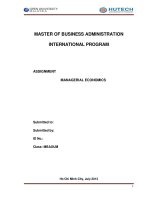Calculus Assignment HCMUT
Bạn đang xem bản rút gọn của tài liệu. Xem và tải ngay bản đầy đủ của tài liệu tại đây (770.27 KB, 13 trang )
VIETNAM NATIONAL UNIVERSITY – HO CHI MINH CITY
HO CHI MINH CITY UNIVERSITY OF TECHNOLOGY
CALCULUS 1 – ASSIGNMENT SUBMISSION
GROUP 8:
……………………………………………………………………………………
…………………………………………………………………………………….
Instructor: Lê Thái Thanh
Group members
Trần Đình Đăng Khoa
Phan Anh Quân
Lê Xuân Phúc
Lê Minh Tuấn
Student ID
2211649
2212809
2153698
2153943
Ho Chi Minh City, Vietnam – 2022
Question 1. A cell phone plan has a basic charge of $35 a month. The plan
includes 400 free minutes and charges 10 cents for each additional minute
of usage. Write the monthly cost C as a function of the number x of
minutes used and graph C as function of x for 0 ≤ x ≤ 600.
Solution:
10 cents = $0.1
35,
0.1𝑥 + 35,
𝐶 (𝑥 ) = {
𝑖𝑓 𝑥 ≤ 400
𝑖𝑓 𝑥 > 400
Where as:
C(x) : cost ($)
x : time used (minutes)
GRAPH OF C(X)
100
95
90
80
C(X) ($)
70
60
50
40
35
35
30
20
10
0
0
100
200
300
X (MINUTES)
400
500
600
Question 2. Evaluate lim(𝑒 𝑥 + 𝑒 −𝑥 − 2) . cot 𝑥
𝑥→0
Solution:
lim (𝑒 𝑥 + 𝑒 −𝑥 − 2) . cot 𝑥
𝑥→0
=
lim
1
cot 𝑥
𝑥→0
= lim
𝑥→0
= lim
𝑥→0
=
−𝑥
(𝑒𝑥 + 𝑒 −2)
(𝑒 𝑥 + 𝑒 −𝑥 −2)
tan 𝑥
(𝑒 𝑥 − 𝑒 −𝑥 )
1
1+𝑥2
(𝑒 0 − 𝑒 −0 )
=0
1
1+02
(Applying L’Hôpital’s Rule)
Question 3. Sketch the graph of the function y =
𝑥 3 −3𝑥
x2 −1
Solution:
• Domain of y:
𝑥 ≠ −1
𝑥 ≠ 1
x 2 − 1 ≠ 0 => {
𝐷 = 𝑅/{−1, 1}
• Roots of y:
𝑥 3 −3𝑥
x2 −1
•
= 0 =>
𝑥= 0
𝑥 − 3𝑥 = 0 => [𝑥 = −√3
𝑥 = √3
3
Asymtotes:
o Vertical:
𝑥3 − 3𝑥
= +∞
𝑥→−1 x2 − 1
𝑥3 − 3𝑥
lim+
= −∞
𝑥→−1 x2 − 1
lim−
=> x = -1 is a vertical asymtote of y.
𝑥3 − 3𝑥
lim
= +∞
𝑥→1− x2 − 1
𝑥3 − 3𝑥
lim
= −∞
𝑥→1+ x2 − 1
=> x = 1 is a vertical asymtote of y.
o Horizontal
𝑥3 − 3𝑥
lim
= −∞
𝑥→−∞ x2 − 1
𝑥3 − 3𝑥
lim
= +∞
𝑥→+∞ x2 − 1
=> The function y has no horizontal asymtote.
• First order derivative of y:
y’ =
𝑑
𝑑𝑥
𝑥 3 −3𝑥
( x2−1 )
(𝑥 3 − 3𝑥 )′(x 2 − 1) − (𝑥 3 − 3𝑥 )(x 2 − 1)′
=
(𝑥 2 − 1)2
(3𝑥 2 − 3)(x 2 − 1) − (𝑥 3 − 3𝑥 )(2x)
=
(𝑥 2 − 1)2
(3𝑥 4 − 6𝑥 2 + 3) − (2𝑥 4 − 6𝑥 2 )
=
(𝑥 2 − 1)2
𝑥4 + 3
=
(𝑥 2 − 1)2
=> The function is monotonically increasing on its Domain
• Graph:
Question 4. Given a function 𝑦 = 𝑦(𝑥) in the implicit form 𝑒 𝑦 + 𝑥𝑦 = 𝑒.
Find 𝑦 ′ (0) if 𝑦(0) = 1.
Differentiate both sides:
𝑑 𝑥
𝑑
(𝑒 + 𝑥𝑦) =
(𝑒)
𝑑𝑥
𝑑𝑥
𝑑 𝑦
𝑑
(𝑥𝑦) = 0
=>
(𝑒 ) +
𝑑𝑥
𝑑𝑥
=>
𝑑𝑦
𝑑
𝑑
=> 𝑒 𝑦 ( (𝑦)) + 𝑥 [ (𝑦)] + 𝑦 [ (𝑥)] = 0
𝑑𝑥
𝑑𝑥
𝑑𝑥
=> 𝑒 𝑦 (
𝑑𝑦
𝑑𝑦
)+𝑥( )+𝑦 = 0
𝑑𝑥
𝑑𝑥
𝑑𝑦
) (𝑒 𝑦 + 𝑥) = −𝑦
𝑑𝑥
𝑑𝑦
−𝑦
=> ( ) = 𝑦
𝑑𝑥
𝑒 +𝑥
−𝑦
=> 𝑦 ′ (𝑥) = 𝑦
𝑒 +𝑥
=> (
Since, 𝑦(0) = 1 => 𝑥 = 0 and 𝑦 = 1
Then,
𝑦’(0) =
−1
−1
=
𝑒1 + 0
𝑒
+∞
Question 5. Evaluate ∫2
+∞
√(𝑥 2 + 5)3
𝑥 𝑑𝑥
𝐼 = ∫
2
𝑥 𝑑𝑥
√(𝑥2
3
+ 5)
Let 𝑡 = 𝑥 2 + 5
=> 𝑑𝑡 = 2𝑥𝑑𝑥
Lower limit: 22 +5=9
Upper limit: +∞
∞
𝐼=∫
9
1 𝑑𝑡
𝑡 3/2 2
1 ∞ −3/2
= ∫ 𝑡
𝑑𝑡
2 9
3
1 𝑡 −2+1
=
2−3 + 1
2
=
1
−
−𝑡 2
1
= −(0 − 9−2 ) =
1
3
Because as 𝑡 → +∞,
1
𝑡
→ 0 =>
1
√𝑡
→0
1
Question 6. Find the arc length of the curve 𝑦 = 3 (3 − 𝑥)√𝑥 ,
where 0 ≤ 𝑥 ≤ 3.
1
1
𝑦 = (3 − 𝑥)√𝑥 = (3√𝑥 − 𝑥 3/2 )
3
3
1 3
3
1
√𝑥
=> 𝑦’ = (
− √𝑥) =
−
3 2 √𝑥 2
2
2 √𝑥
=> 1 + (𝑦′)2 = 1 + (
=1+
=(
1
2√𝑥
1
4𝑥
𝑥
1
4
2
+ −
√𝑥
2
)2 + ( )2 + 2.
1
2√𝑥
1
−
√𝑥 2
)
2
√𝑥
2√𝑥 2
.
=(
The arc length of the curve is:
𝑏
L = ∫𝑎 √1 + (𝑦′)2 𝑑𝑥
3
= ∫0 (
2
1
√𝑥
= √𝑥 +
= 2 √3
+
√𝑥
) 𝑑𝑥
2
𝑥 3/2
3
1
2√𝑥
+
√𝑥
)
2
Question 7. Solve the differential equation 𝑦 ′ + 5𝑦 = −3𝑒 2𝑥
Multiply each term by the integral factor 𝑒 5𝑥
𝑒 5𝑥
𝑑𝑦
+ 5𝑦𝑒 5𝑥 = −3𝑒 7𝑥
𝑑𝑥
Integrate on each side.
∫
𝑑𝑦 5𝑥
[𝑒 𝑦] 𝑑𝑥 = ∫ −3𝑒 7𝑥 𝑑𝑥
𝑑𝑥
Integrate the left side.
𝑒 5𝑥 𝑦 = ∫ −3𝑒 7𝑥 𝑑𝑥
Integrate the right side.
3
𝑒 5𝑥 𝑦 = − 𝑒 7𝑥 + 𝐶
7
3
Divide each term in 𝑒 5𝑥 𝑦 = − 𝑒 7𝑥 + 𝐶 give 𝑒 5𝑥 and abbreviated.
7
𝑦=−
3𝑒 2𝑥
7
+
𝐶
𝑒 5𝑥
Question 8. Solve the differential equation 𝑦 ′′ + 6𝑦 ′ + 5𝑦 = 8𝑥𝑒 −𝑥
𝑑
𝑑2
5𝑦(𝑥) + 6 𝑦(𝑥) + 2 𝑦(𝑥) = 8𝑥𝑒 −𝑥
𝑑𝑥
𝑑𝑥
This differential equation has the form:
y’’ + p*y’ + q*y = s,
where
p = 6, q = 5, s = −8𝑥𝑒 −𝑥
It is called linear inhomogeneous second-order differential equation with
constant coefficients.
The equation has an easy solution.
We solve the corresponding homogeneous linear equation.
y’’ + p*y’ + q*y = s,
First of all we should find the roots of the characteristic equation
𝑞 + (𝑘 2 + 𝑘𝑝) = 0
In this case, the characteristic equation will be:
𝑘 2 + 6𝑘 + 5 = 0
- this is a simple quadratic equation
The roots of this equation:
𝑘1 = −5
𝑘2 = −1
As there are two roots of the characteristic equation, and the roots are not
complex, then solving the correspondent differential equation looks as follows:
𝑦(𝑥) = 𝐶1 𝑒 𝑥𝑘1 + 𝐶2 𝑒 𝑥𝑘2
𝑦(𝑥) = 𝐶1 𝑒 −5𝑥 + 𝐶2 𝑒 −𝑥
We get a solution for the correspondent homogeneous equation
Now we should solve the inhomogeneous equation
y’’ + p*y’ + q*y = s,
Use variation of parameters method
Suppose that C1 and C2 - it is functions of x
The general solution is:
𝑦(𝑥) = 𝐶1 (𝑥)𝑒 −5𝑥 + 𝐶2 (𝑥)𝑒 −𝑥
where C1(x) and C2(x)
by the method of variation of parameters, we find the solution from the system:
𝑦1 (𝑥)
𝑑
𝑑
𝐶1 (𝑥) + 𝑦2 (𝑥) 𝐶2 (𝑥) = 0
𝑑𝑥
𝑑𝑥
𝑑
𝑑
𝑑
𝑑
𝐶1 (𝑥) 𝑦1 (𝑥) +
𝐶2 (𝑥) 𝑦2 (𝑥) = 𝑓(𝑥)
𝑑𝑥
𝑑𝑥
𝑑𝑥
𝑑𝑥
The free term f = -s, or
𝑓(𝑥) = 8𝑥𝑒 −𝑥
So, the system has the form:
𝑒 −𝑥
𝑑
𝑑
𝐶2 (𝑥) + 𝑒 −5𝑥
𝐶 (𝑥) = 0
𝑑𝑥
𝑑𝑥 1
𝑑
𝑑
𝑑
𝑑
𝐶1 (𝑥) 𝑒 −5𝑥 +
𝐶2 (𝑥) 𝑒 −𝑥 = 8𝑥𝑒 −𝑥
𝑑𝑥
𝑑𝑥
𝑑𝑥
𝑑𝑥
Solve the system:
𝑑
𝐶 (𝑥) = −2𝑥𝑒 4𝑥
𝑑𝑥 1
𝑑
𝐶 (𝑥) = 2𝑥
𝑑𝑥 2
-it is the simple differential equations, solve these equations
𝐶1 (𝑥) = 𝐶3 + ∫(−2𝑥𝑒 4𝑥 )𝑑𝑥
𝐶2 (𝑥) = 𝐶4 + ∫ 2𝑥 𝑑𝑥
Substitute found C1(x) and C2(x) to
𝑦(𝑥) = 𝐶1 (𝑥)𝑒 −5𝑥 + 𝐶2 (𝑥)𝑒 −𝑥
The final answer:
𝑦(𝑥) = 𝐶3 𝑒
−5𝑥
+ 𝐶4 𝑒
−𝑥
+𝑥 𝑒
Where c3 and c4 is a constants
𝑥
𝑦(𝑥) = (𝐶1 + 𝐶2 𝑒 −4𝑥 + 𝑥 2 − ) 𝑒 −𝑥
2
2 −𝑥
𝑥𝑒 −𝑥 𝑒 −𝑥
−
+
2
8
Question 9. Solve the system of 1-st order differential equations
𝑥 ′(𝑡) = 𝑥(𝑡) + 2𝑦(𝑡) + 1
{ ′
𝑦 (𝑡) = 2𝑥(𝑡) − 𝑦(𝑡) + 2
Let 𝑃 ∶ 𝑥 ′ (𝑡) = 𝑥(𝑡) + 2𝑦(𝑡) + 1 }
𝑄 ∶ 𝑦 ′ (𝑡) = 2𝑥(𝑡) − 𝑦(𝑡) + 2
• 𝑄 – two times 𝑃 => 𝑦’ – 2𝑥’ = −5𝑦 (1)
• Differentiate 𝑄 => 𝑦’’ = 2𝑥’ – 𝑦’ (2)
From (1) and (2) => 𝑦’’ = 5𝑦
• Characteristic equation: 𝑘 2 − 5𝑘 = 0 => 𝑘 = 5 (double root)
5𝑡
=> 𝑦 = 𝐶₁𝑒 + 𝐶₂𝑡𝑒 5𝑡
5𝑡
=> 𝑦’ = 5𝐶₁𝑒 + 𝐶₂𝑒 5𝑡 + 5𝐶₂𝑡𝑒 5𝑡
We also have 𝑥
=
−𝑦−𝑦′ +2
2
(𝑄)
Substitute 𝑦 and 𝑦’ in 𝑄
We obtain
1
𝑥 = −3𝐶₁𝑒 5𝑡 − 3𝐶₂𝑡𝑒 5𝑡 − 𝐶₂𝑒 5𝑡 + 1
2
Question 10. An aquarium 2 𝑚 long, 1 𝑚 wide, and 1 𝑚 deep is full of
water. Find the work needed to pump half of the water out of the aquarium.
(Use the fact that the density of water is 1000 𝑘𝑔/𝑚3 .)
We got: 𝑊 = 𝐹. 𝑠
In this case, we divide upper half of the aquarium into horizontal slices and use
Intergral to calculate Work we need to pump. We use set the range from 0 which
is the top of the Aquarium to its half position which is ½.
So we got our General Formula for Work:
W = ∫01/2 (𝑑𝑒𝑛𝑠𝑖𝑡𝑦). (𝑎𝑟𝑒𝑎 𝑜𝑓 𝑒𝑎𝑐ℎ 𝑠𝑙𝑖𝑐𝑒𝑠). (𝑔𝑟𝑎𝑣𝑖𝑡𝑦). (𝑑𝑖𝑠𝑡𝑎𝑛𝑐𝑒)
In which:
- Density of water = 1000 𝑘𝑔/𝑚3
- Area of the aquarium is the area of each slices
o 𝐴 = 𝐿𝑒𝑛𝑔𝑡ℎ . 𝑊𝑖𝑑𝑡ℎ = 2.1 = 2 𝑚2
- Gravity: The force from the Earth ( 𝑔 = 9.8 𝑚/𝑠 2 )
- Distance: We give Distance a variable 𝑥 to calculate the work with
intergral.
1
2
∫ 1000 × 2 × 9.8 × 𝑥𝑑𝑥
0
1/2
1000 × 2 × 9.8 × ∫0
𝑥𝑑𝑥
1
19600 × ( ×
2
From this calculation we got
𝑊 = 2450 𝐽
1
𝑥 2 | 02
)









